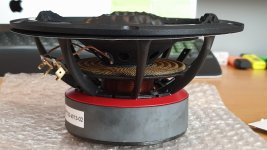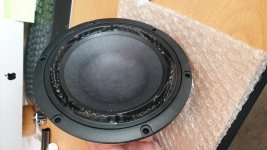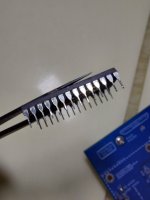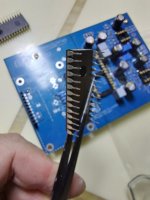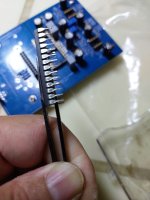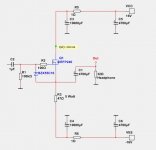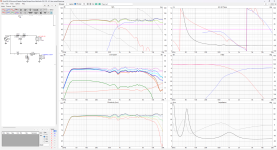VRDN: bipolar regulator PCB for line level ckts: ±11V to ±20V @ 1.5A with "De-Noiser"
A couple of diyAudio members and I perceived the need for a power supply board aimed at line level applications, such as for example
Wayne's BA 2018 linestage. We felt it should include the following features:
- Rectifier diodes on board
- Transformer snubbers on board
- Usable with both dual-secondary and single-secondary transformers (AC-to-AC wall warts)
- True 1.5 ampere output capability, therefore: real heatsinks & big capacitors
- Output voltages field adjustable via multi-turn trimpots
The result is a PCB called "VRDN" - Voltage Regulator with De-Noiser technology. The DN technology was originally invented and published by Charles Wenzel, whose original article called it "Finesse"
(link) . DN technology was greatly improved and expanded by diyAudio member Elvee, who named the improved circuit his "De-Noiser"
(link) This regulator PCB implements De-Noiser circuitry, as shown in the schematic of Figure 1 below.
Capacitor C13, and everything to the right of C13, are the De-Noiser. Jumper block J3 allows you to easily disable the De-Noiser (jumper installed) or enable it (jumper removed). This gives the pleasant option of performing a before-and-after pair of tests, either with measuring equipment OR with human listeners. Try it one way, then try it the other. Which do YOU prefer?
The board includes two transformer secondary snubbers, namely (MOV1, C1, R1) and (MOV2, C2, R2). Metal Oxide Varistors perform double duty in these snubbers, serving as the across-the-secondary capacitance "Cx" and also acting as voltage clamps, if an AC mains spike or surge occurs. The values of snubbing resistors R1 and R2 were chosen after performing several Quasimodo tests on several different transformers, and I expect these resistor values will work well IN THIS PARTICULAR CIRCUIT, with a wide variety of different transformers. However, if you wish to perform your own Quasimodo tests on your own transformer, and derive your own optimum values for R1 and R2, please go right ahead with my blessings and good wishes. Just remember to insert your actual MOV1 component into your Quasimodo's "Cx" socket.
Figure 1 includes two bridge rectifier components, BR1 and BR2. Each of these implements a "Full Wave" rectifier, meaning it transfers energy from the AC mains to the DC filter capacitors, two times per cycle: once at the peak of the mains sine wave, and once at the trough. The circuit contains two Full Wave rectifiers, one per transformer secondary. One of them produces the positive DC voltage output, and the other produces the negative DC voltage output.
However, when conceiving this board, we envisioned that some hobbyists might wish to build a bipolar regulated supply but feed it from an AC-to-AC wall wart instead. This has the great advantage that it keeps the mains voltage completely away from the DIY chassis; instead of 115VAC or 230VAC, the wires which enter the chassis carry only 16VAC or 18VAC, which is noticeably less dangerous. An AC-to-AC wall wart also allows a smaller DIY chassis with less interior volume, since the transformer is now outside rather than inside the chassis. But an AC wall wart is just a transformer with a single secondary.
VRDN implements the conventional, textbook method for creating a bipolar DC supply from a single secondary transformer. It's called a "Half Wave" rectifier, and as the name suggests, it transfers energy from the AC mains to the DC filter capacitors, only one time per cycle: either at the peak, or the trough, of the mains sine wave. One HWR generates the positive DC voltage output, and the other HWR generates the negative DC voltage output. Exactly as is done in the Objective-2 headphone amplifier, among MANY other examples.
To use the VRDN board with a single secondary, AC-to-AC wall wart, we need to make a few very minor adjustments. They are tabulated in Figure 2 below. As you can see, the only changes are to the list of stuff-and-solder actions. No PCB tracks need to be cut, no soldermask needs to be scraped off. You simply do-not-stuff six components, add three jumper wires (each 2.5mm long) into pre-labeled locations, and stuff two discrete diodes into existing & labeled thru-holes. It's easy.
Figure 3 shows two VRDN boards. The top PCB in the photo is configured for a dual secondary transformer -- notice it has two green Euroblok connectors at the left edge of the board. One connector for each secondary. The bottom board is configured for a single secondary AC-to-AC wall wart. It has only one Euroblok connector and only one snubber at the left edge of the board. Everything else on the two boards is identical.
Figure 4 is a detailed picture of the input circuitry, on a PCB configured for two secondaries. Again notice the two Euroblok connectors.
Figure 5 is a detailed picture of the same region, this time on a PCB configured for a single secondary AC-to-AC wall wart. You can see that the bridge rectifiers are not stuffed, the (MOV2, C2, R2) snubber is not stuffed, and the Euroblok connector is not stuffed. You can also see that the three jumper wires "JOR1, JOR2, JOR3" have been stuffed -- look for pink arrows on the photo. Discrete Schottky diodes (5 amperes, 100 volts rated) have been stuffed -- look for gold stars. One diode is stuffed in holes "A" and "C", the other diode is stuffed in holes "L" and "M". Exactly as required by the options table shown in Figure 2.
The Jumper Options are shown on the schematic as 22 megohm resistors. This is a limitation of the CAD system and, specifically, a limitation of the CAD system USER, namely me. In truth, in real life, on your real PCB, JOR1 is either a zero ohm resistor (i.e. a piece of 22AWG hookup wire with white insulation) or else it is an INFINITY ohm resistor (i.e. an open circuit; nothing stuffed). Same goes for JOR2 and JOR3. Completely disregard "22 megohms" on the schematic. Ignore it. Pay it no attention. Simply remember that JOR1-3 are either opens or shorts. Opens or shorts. Repeat after me: opens or shorts. Look at the photos in Figures 4 and 5. Those options are either not-stuffed-at-all (open) or else stuffed with hookup wire (shorts). You can see them right in the photographs. Repeat after me: opens or shorts.
Figure 6 is a photograph of the output side of the PCB. Individual wire-to-board connections are provided for supply and ground, for each of two stereo channels. Also visible in this photograph are the vertically mounted resistors. This PCB uses the vertical orientation exclusively. Finally if you look very closely, you can see the amber colored Kapton tape on the back of the heatsinks.
TIPS FOR BUILDERS
Please carefully study the top silkscreen text layer when stuffing and soldering the 1N4004 diodes and the 1N4148 diodes. There is a little "A" next to each hole where an Anode is soldered. You'll find that on every 1N4004 and 1N4148, the cathode (band end) of the diode is the short wire which is stuffed straight thru the PCB with no bends; the cathode is the "butt end" of the vertical diode. The anode wire is the one which is bent into a 180 degree U-Turn, and is exposed for easy probing. The anode wire goes into the PCB hole with the little letter "A" on silkscreen.
First stuff and solder all resistors and axial diodes. Second, stuff and solder the MOVs and the bridge rectifiers (if using!!). Third, stuff and solder the Euroblok connectors and the two pin headers J3 and J4. Fourth, stuff and solder the small (non 2200uF) capacitors, the trimmer pots, and the transistors. Fifth, stuff the regulators-on-heatsinks (next paragraph).
After you bolt the LM317 and LM337 to their heatsinks, including the Sil-Pad insulator and the insulated shoulder washer / bushing, I recommend that you test-fit one of them into the PCB. You will discover that your unmodified assemby doesn't quite fit! You'll need to modify it. Bend the leads of the TO-220, backwards (towards the heatsink) about 1-2 millimeters. Try this. Aha! Now it fits. Put a piece of Kapton insulating tape on the back of each heatsink, over the TO-220 mounting bolt. The two heatsinks are positioned back-to-back and we don't want them to come into electrical contact. Kapton tape prevents that.
Stuff the regulators-on-heatsinks so the heatsink edges are flush with the PCB, but only solder the IC legs for now. Do not solder the heatsink mounting pins yet. Instead, turn the board right side up and look at the heatsinks placed back to back. You want to see a nice wide air gap between the two heatsinks, about 3-6 millimeters wide. When building my boards, I folded a sheet of paper in half, and half again, and again, etc., until I had a bundle 5mm thick. Then I jammed this paper bundle down between the two heatsinks to create a definite gap between them. With the paper in place, enforcing a nice gap, THEN I soldered the four heatsink mounting pins in place. After the solder joints cooled, I removed the paper bundle and voila! A nice, permanent, air gap between the two heatsinks.
Finally, stuff and solder the twelve 2200 microfarad capacitors.
SUMMARY OF FEATURES AND MIS-FEATURES
- De-Noiser circuit with jumper enable/disable
- Diodes on PCB
- Transformer Snubbers on PCB
- Big capacitors on PCB allowing true 1.5A output
- No bleeder resistors on PCB
- Voltage regulator ICs mounted on heatsinks for true 1.5A output
- Heatsink thermal resistance is 8.6 deg C per watt
- This is a four layer PCB, three of which are ground planes
- Gerber CAD files freely available, send to any fab you wish
- No "pilot light" LEDs on DC outputs
- Can use with either dual secondary trafo or AC-to-AC wall wart
- No SMD components; 100% thru-hole
- PCB unique identifier is TZPTR7 ; suffix -A means "revision A"
- PCB mounting holes compatible with Modushop chassis baseplate
- Board size 62 x 142 mm (edges) ; 50 x 130 mm (holes)
NEW INFORMATION
- 2023-12-21: a Forum member has created a new PCB layout of VRDN with only two layers. He has made the Gerber files freely downloadable in (this thread). Be sure to read his Disclaimer and non-Guarantee at the bottom of post #1.








